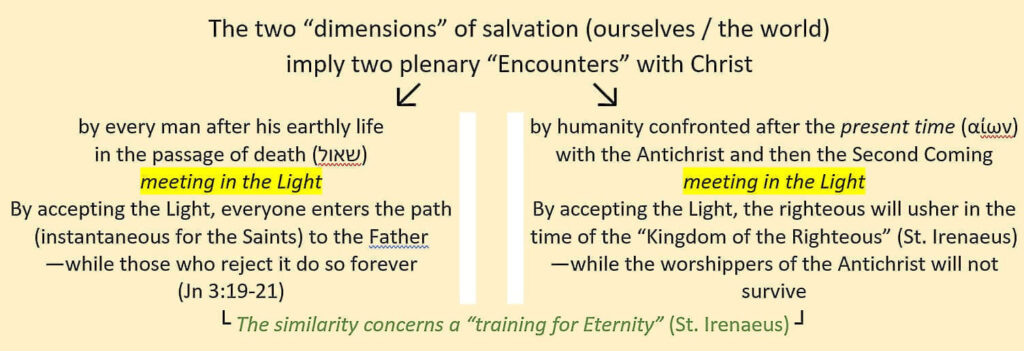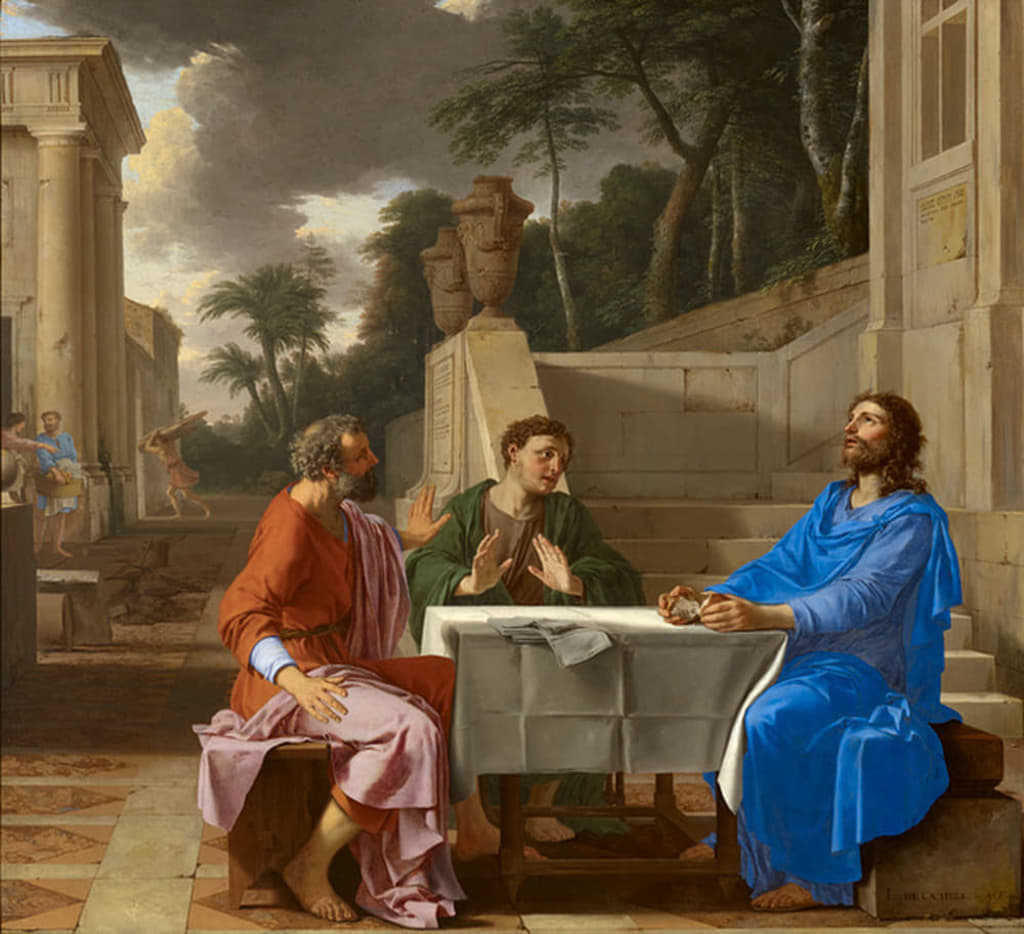Spontaneously, all converts say, “I met Jesus.” What do they mean?
What is mysterious is not only the fact that it is Jesus, but the fact of the encounter itself. The main nowadays common meaning of the verbs “to encounter” or “to meet” are not so old. Previously, converts could only say, “I have found Jesus, or “I have known Jesus.” In the first case, one is tempted to ask them “where;” and in the second “how.” Some word was missing to carry an important unspoken meaning; and this lack seriously handicapped ancient theology, Latin or Greek.
The old meaning of “to meet” ‒from Germanic origin‒ was “to come into the same place with.” Later on, a possible physical contact was added to the meaning, or in the figurative sense of an agreement. For its part, the word “encounter” was built on the French adverb “contre” (Latin “contra”, in front of, against) with the thought of a confrontation. These words are however inadequate to describe the experience of the converts.
A Word to Say What?
Indeed, there is a difference between being with someone in the same room and actually meeting him. When you simply see a person, even if you notice him, nothing happens. But if you stop and talk to that person, something happens—an exchange. From then on, something is changed in me and also in the other person. Of course, things can go wrong and end up in a fight. Or, on the contrary, everything goes so well that in older French, we spoke of “se marier contre un(e) tel(le)” [marrying against such a one]. The word “encounter” gained this perspective of a very particular experience, while it is more the verb “to meet” that suggests it.
What is changed in me and in the other person? It is indefinable precisely; it depends on many things (circumstances, the past). If, therefore, the word “encounter” is too vague to constitute a true concept, it at least means that something has influenced my “personhood” at the same time as that of the other person—the term “person” being a word invented (not in the recent times but as early as the 3rd or 4th century) in order to highlight our becoming [at the beginning of the 6th century, Boethius tried to define what a “person” is; he gave six or seven definitions (it is not simple). He did not create the word, he contributed in popularizing it]—we are individuals endowed with reason and above all with relationships, and therefore perfectible. It is Christians who invented this word. It is also appropriate to speak of the relationships in the very Life of the One God who revealed Himself in three “Persons” who are perfect (they do not need perfection).
In fact, it was also (Western) Christians who extended the meaning of the words “encounter” and “to meet” as we can use them today: an “encounter” of Jesus changes something in our lives and in us—and more than a little. In Aramaic, such a word already existed, so to speak—qurbanah, i.e., to go as far as to touch or be touched; this word was retained to designate what in the West was called “Mass.” The word “mass” does not mean anything; let us imagine that the word “encounter” existed as early as the 2nd century: it would certainly have been used to say that on Sundays, Christians go “to the Encounter.” The term would be defined by itself: to touch/be touched by God. It would have been wonderful.
Each “encounter” with Jesus is a unique but also relative experience. Rather than trying to highlight features that would be common to the testimonies of converts or even to those of other people, it seems more appropriate to look at how all these encounters announce a plenary encounter. For the encounters of Our Lord here below are never absolute—they are clearly foretastes of something that can only take place outside the framework of this present world.
Preparing for a Plenary Encounter
We must therefore speak of a plenary Meeting of Jesus, of which those of our earthly life are, so to speak, preparations. This Encounter that awaits us can have two plenary “forms”:
- the first is that which, in the “depths of death” (Catechism of the Catholic Church no. 635) , awaits the soul of every deceased person facing the soul of Christ “descended into hell” (Sheol– שאול, not Gehenna, the Hell of the doomed, according to Hebrew terminology), an encounter linked to Salvation, for we can only go to the Father through Him whose name means “He saves” or “Salvation” (in Hebrew) [ Introduced by the recalling that Jesus himself descended into the “mystery of death” and that through him “the gospel was also proclaimed to the dead” (1 Pet 4:6), no. 634 constitutes, together with no. 635, the heart of the understanding of the section of the CCC devoted to the Descent into Hell: “‘The gospel was preached even to the dead.’ The descent into hell (שאול) brings the Gospel message of salvation to complete fulfillment. This is the last phase of Jesus’ messianic mission, a phase which is condensed in time but vast in its real significance: the spread of Christ’s redemptive work to all men of all times and all places, for all who are saved have been made sharers in the redemption” (no. 634)];
- the second is the one that historically awaits those who will be on earth at the moment when Christ appears as the “Son of Man,” according to the words of the prophecy of Daniel 7:13 and countless proclamations in the Gospels; and it will be an encounter of Judgment for some, but of salvation-vivification for those who will have waited for it and will have suffered from the Anti-Christ (Heb 9:28).
These are two different things, which are neither superimposed nor combined: personal destiny beyond death and the judgment of humanity are not the same thing, even if we can underline analogies between one and the other, as we shall see, and the experience of the encounter with Christ in the course of our life on earth already has a little to do with both. Of course, it would be necessary to (re)give a whole teaching here on both of these two plenary “forms” of the Encounter with Jesus; we can only refer here to the all too rare serious studies which speak of them.

For some, one difficulty is the nature of the Encounter with Christ, whatever its “form” or its time: an encounter of Light or in the Light (it does not really matter); that would be too simple. The Encounter of the Light is linked to salvation: the light of Christ illuminates the shadows—the turpitudes of the past life—so that one can no longer lie or pretend. One can only ask for forgiveness, which allows one to start moving towards the Light. In the best of cases. For if one refuses to ask for forgiveness, the Meeting turns sour: one will flee from the light (Jn 3:21).
“What you have hidden from the wise and the learned, you have revealed to the little ones,” Jesus tells the Father (Matthew 11:25). Everything is simple for those who want to understand clearly.
[As early as the 17th century, Puritan preachers misunderstood this passage from St. Paul 1Thess 4:15-17: “We who will be left alive in [the length of] the Coming (Aramean: bə-meṯīṯēh) of the Lord, will certainly not precede those who have fallen asleep. For the Lord himself will come down from heaven, with a loud command, with the voice of the archangel and with the trumpet call of God, and the dead in Christ will rise first. After that, we who will be still alive and left will be caught up together with them in the clouds to meet the Lord in the air. And so we will be with the Lord forever.”
They have imagined in it the announcement of a “rapture of the [true] Christians”, whereas what St. Paul describes there, in a somewhat rudimentary way, is what is to happen at the end of the time of the Parousia, “when he will hand over the Kingdom to God the Father” (1Co15:24), i.e. Jesus comes down to hand over the participants of his Kingdom to his Father.
The Anglo-Irish Rev. John Nelson Darby (1800-1882) spread this doctrine of the “Rapture”, which became popular in the United States, to the point of giving rise to a novel (Left Behind) and to a movie; in the rest of the world, this doctrine made people smile].
Theologian and Islamologist, Father Edouard-Marie Gallez is the author of the magisterial Le messie et son prophète (The Messiah and His Prophet), published in Paris in 2005 (and awaiting an English translation), which is an 1100 -page study that reconnects the origins of Islam to factual history by showing that the Koran and Islamic legends developed gradually over time. This study paved the way of current research into early Islam. See Roots of Islam and the Great Secret. Father Gallez also participates in research groups on early Christianity and its influence.
Featured: “Apparition du Christ aux pélerins d’Emmaüs (Appearance of Christ to the Disciples in Emmaus—Supper at Emmaus),” by Laurent de La Hyre; painted in 1656.
